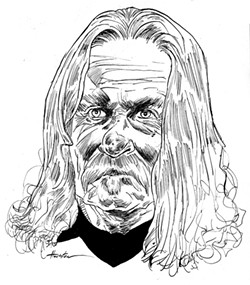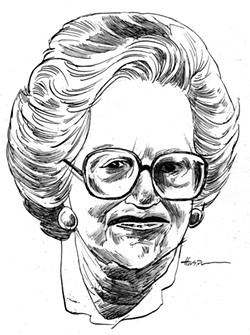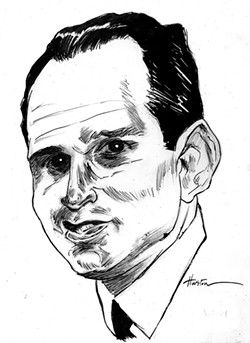Gary Burden
Essential album cover artist of the 1970s
May 23, 1933–March 9, 2018
As an elder millennial, I sort of straddle two worlds: the analog and the digital. I didn't have a cell phone until I was a junior in high school, but I've been downloading music since the days of Napster and Limewire. That being said: I remember what it felt like to hold a CD, tape or record and cherish it in a different way than we do now — an era when we just pay $10 a month for unlimited streams of almost every album of every artist ever.
I specifically remember being in the gigantic Tower Records in New Orleans and flipping through an entire wall of darkwave/industrial CDs, mesmerized by how many they had. Or going home with a brand-new batch of music and sitting on the floor in my bedroom unraveling the album artwork and reading the lyrics along to the music.
It was quite a different age, and some of the folks that helped make it so were the geniuses behind some of those album covers.
Enter: Gary Burden.
If you dig classic folk-rock, you probably remember the cover of Joni Mitchell's Blue album, a close-up, high-contrast midnight-blue portrait of Mitchell gazing downward. It's melancholic and rich and, most of all, it evokes feeling in the viewer. Burden designed that. The former architect was a sought-after album designer starting in the late '60s for many a rock & roller, from Mitchell, the Doors and Crosby, Stills, Nash and Young to current artists like Conor Oberst, best known for his work in the emotive indie-folk project Bright Eyes.
"Gary always wanted the album packaging to reflect the spirit of the music and the wishes of the artists as much as possible," Oberst said in a recent article in the New York Times. "He was often at odds with record labels when they sought to cut costs at the expense of what he and the artist had envisioned. Gary usually won those battles."
While studying architecture at UC Berkeley, Burden met Cass Elliot of the Mamas and the Papas, who would ultimately be the one to turn him on to designing album covers for a living. "I met her and she asked me to do a remodel of her home in Laurel Canyon," Burden said in a 2015 video interview with NPR's World Café. "So she's the one who said, 'You know, Gary, you should make our new cover; you know how to design stuff,'" he recalled.
The rest, you could say, is history. After a lifetime of contributing his own art to the music community, Burden died this year on March 7. No cause was given.
As time seems to slip faster beneath us and technology speeds the world up, Burden's death is a reminder to slow down and look at the details, to feel the textures and edges and maybe sit with — and breathe with — a piece of album art. It'll most likely enhance the entire musical experience. — Chris Conde
Arnie Lerma
Ex-Scientologist who became Scientology's fiercest critic
Nov. 15, 1950–March 16, 2018
Ever heard the story of Xenu, the genocidal alien dictator who, when faced with overpopulation troubles 75 million years ago, brought billions of his subjects to Earth to execute with a lethal combination of volcanoes and hydrogen bombs; their disembodied spirits to cling to humans and their removal can only be achieved through the teachings of the Church of Scientology? If so, you can thank Arnie Lerma.
Arnaldo Pagliarini Lerma was born in Washington, D.C., in 1950, to a mother who was an executive secretary to the Sudanese ambassador and a father who was a Mexican agriculture official — and who divorced months after his birth, according to Lerma's autobiography. His mother was a Scientology official in the D.C. church around 1968, about three decades after American science fiction writer L. Ron Hubbard published the first texts that would form the basis of his new religion, Scientology. By the time Lerma joined Scientology at 16 at the urging of his mother, the church had been banned in several Australian states and stripped of its tax-exempt status by the IRS, which deemed it a commercial operation for Hubbard's benefit — though a U.S. appeals court later recognized it as a religion in 1969.
Lerma signed a "billion-year contract" to serve in Scientology's elite Sea Org, a paramilitary force that some have described as a totalitarian organization, according to the Washington Post. But his status among fellow Scientologists changed when Lerma and Hubbard's daughter, Suzette, fell in love (a claim that has been strongly disputed by the church). Lerma's entanglement with Scientology ended after other Sea Org members allegedly threatened to mutilate him if he didn't cancel his elopement with Suzette Hubbard.
Exiled from the religion that had been his home for years, Lerma became one of Scientology's fiercest critics. By 1994, he was posting public court documents involving the church online in the alt.religion.scientology newsgroup that "included testimony from former church officials who describe Scientology as a dangerous cult that brainwashes and blackmails its members and harasses defectors and critics," which earned him intimidating visits from men in dark suits at his Arlington home, according to the Post. In 1995, Lerma was the first to post the "Fishman Affidavit" — documents submitted by ex-Scientologist Steven Fishman that included criticisms of the church as well as the doctrine of Xenu, which Scientology officials argued was copyrighted and a trade secret.
The church accused Lerma of copyright infringement and trade secret misappropriation, leading to a raid of his home by his home by federal marshals, Scientology attorneys and data technicians. The church's Religious Technology Center sued Lerma, his internet service provider and Post reporters for quoting the affidavit. A federal judge found the reporters had not violated copyright for quoting a publicly available court document, but Lerma was held liable for a small number of non-willful copyright violations and ordered to pay a $2,500 penalty. The court, however, stated in its 1995 ruling that it was convinced "that the primary motivation of RTC in suing Lerma, DGS and the Post is to stifle criticism of Scientology in general and to harass its critics."
Lerma continued his crusade against Scientology on his website, Lermanet, which became a resource for other critics, and gave interviews on the subject in print news stories, television and radio.
On March 16, Lerma, 67, shot his wife, Ginger Sugerman, in the face with a handgun at their Georgia home before killing himself, according to the local newspaper the Sylvania Telephone. Sugerman, 58, survived and told Tony Ortega — the former Village Voice editor who runs The Underground Bunker, a site that keeps a sharp eye on the world of Scientology — that her husband was taking oxycodone in his last months to deal with back pain and that his paranoia had increased. Ortega last reported that Sugerman, also a former Scientologist, was raising funds for her continuing surgeries and for efforts to honor Lerma's work, despite his last atrocity. — Monivette Cordeiro
Judith Leiber
Holocaust survivor and designer of extravagant handbags
Jan. 11, 1921–April 28, 2018
If you can't connect the dots between the words "handbag" and "art," you're probably not versed in the distinctive work of Judith Leiber, the late Hungarian designer who took a signature concept — whimsical metal clutches adorned with Swarovski crystals and semi-precious stones — and ran with it in vivid fashion for decades.
Born Judit Peto into a Jewish family in Budapest in 1921, she escaped the worst atrocities of the Holocaust and weathered World War II in a Budapest apartment in the Jewish ghetto reportedly shared by 26 people. Although she aimed for a job in the cosmetics industry, she instead became the first woman to work at the Hungarian Handbag Guild, where she perfected design and fabrication skills from the ground up. In 1945, while selling her own handmade purses on the side, she met Gerson "Gus" Leiber, a Brooklyn-born Army sergeant and modernist painter stationed in Budapest. By 1947, they were married and living in New York City.
In New York, she worked for handbag manufacturers and hit an early career high in 1953 when First Lady Mamie Eisenhower arrived at the Inaugural Ball carrying a small, bedazzled clutch crafted by Leiber. Credit went to her employer (designer Nettie Rosenstein), but this turn of events foreshadowed a trend of powerful women — from queens and movie stars to first ladies Lady Bird Johnson, Nancy Reagan, Barbara Bush, Hillary Clinton and Laura Bush — clutching Leiber's shimmering creations at high-profile events.
In 1963, the couple officially dove into the luxury handbag business together via Judith Leiber Inc., with Gerson on the business end and Judith handling design, fabrication and marketing.
In the decades that followed Leiber took her playful, over-the-top aesthetic to the limit while challenging the confines of minaudières — decorated metal clutches only big enough to carry what she summed up as "a handkerchief, lipstick and a $100 bill."
Beyond meticulous attention to detail and unapproachable price tags, one of the most remarkable aspects of Leiber's work is the juxtaposition of refined materials and techniques with nostalgic, child-like, even lowbrow themes and concepts. Her unapologetically extravagant minaudières — which have taken shape in dazzling cupcakes, ladybugs, cameras, cell phones, bundles of asparagus, Tutankhamen-inspired monkeys, burgers, fries and cocktails — have long been slyly witty staples for A-list celebrities on often-humorless red carpets.
Although the Leibers sold their business in 1993 for a reported $16 million (Judith stayed on board as designer until 1997), the Judith Leiber brand is still intact and active, offering a reverent continuum of the 5,000-plus designs its co-founder created throughout her colorful career. In 2005, Judith and Gerson opened the Leiber Collection in Springs, New York, to "house their works of art and to chronicle their careers." While both are represented in major museum collections (he's in the Museum of Modern Art and the Brooklyn Museum; she's in the Smithsonian and the Met), the Leibers were thoughtfully showcased side by side in a trio of recent exhibitions while they were both in their 90s. After 72 years of marriage, Judith and Gerson died at home within hours of one another, both from heart attacks, on April 30, 2018.
As for the shimmering body of work she began building long before "bling" was even a blip on Merriam-Webster's radar, Judith Leiber presented her intricate evening bags as defiant status symbols, conceptual confections and wacky conversation pieces. All you need to enjoy one is a big bank account, a sense of humor sized to match and, as Leiber once suggested, an escort to carry the items that don't fit in your minaudière. — Bryan Rindfuss
Glenn Snoddy
Recording engineer and inventor of the fuzz tone
May 4, 1922-May 21, 2018
Glenn Snoddy's contribution to the world of music wasn't a song or a style of playing. It was more like he helped discover a new color.
A recording engineer in Nashville in the early 1960s, Snoddy helped capture and re-create what is commonly called "fuzz tone," the distorted, overdriven effect that helped shape the sound of modern rock & roll.
And it was all, quite literally, by accident.
Already a recording veteran (he'd worked on pivotal sessions for Patsy Cline, Hank Williams and Johnny Cash), Snoddy was manning the console for a session with producer Don Law and country singer Marty Robbins, who was recording his 1961 single "Don't Worry." A broken amplifier that the bass was running through created a dirty sound about halfway into the recording that caught the attention of everyone working on the track.
"The transformer in the amplifier blew up," Snoddy told Murfreesboro, Tennessee's Daily News Journal in 2016 about the happy accident. The bassist (country and rockabilly session guitarist Grady Martin) reportedly wanted to redo his part, but Law and Snoddy insisted it remain.
After its release, "Don't Worry" went to No. 1 on Billboard's singles chart and musicians in particular loved the buzzy sound. Snoddy says Nancy Sinatra was in Nashville and wanted that exact sound for a recording session, but by that point the original "broken" amp had completely died. So he began figuring out how to re-create the fuzz, designing and building a preamp effects box to capitalize on the curiosity. He sold the design to Gibson, which turned it into the Maestro Fuzz-Tone FZ-1, the first commercially available guitar distortion pedal.
While the distorted guitar sound was pioneered by players like Howlin' Wolf guitarist Willie Lee Johnson and Link Wray (most notably on the revolutionary 1958 instrumental hit "Rumble") in the decade leading up to his invention, Snoddy was the first to capture that fuzzy lightning in a bottle (or, rather, box). The Gibson pedal (which initially sold for $40) wasn't an immediate hit and the company ramped down production of them until 1965, when Rolling Stones guitarist Keith Richards used his FZ-1 on the band's seminal hit, "Satisfaction." Gibson sold 40,000 pedals in the wake of that song's success, after reportedly moving a grand total of three over the course of the previous two years.
The fuzz tone sound became the foundation of '60s and '70s rock & roll, leading the way for other popular pedals, including the Fuzz Face, beloved by Jimi Hendrix and Pete Townshend, and the Big Muff, which saw a revival in the late '80s/early '90s, the key to the guitar sounds of bands like Mudhoney, Smashing Pumpkins and many other alternative rock acts of the time.
Snoddy, who'd later open Nashville's Woodland Sound recording studio (home to many important sessions, including the one for the Nitty Gritty Dirt Band's "Will the Circle Be Unbroken"), died on May 21. He was 96. — Mike Breen










